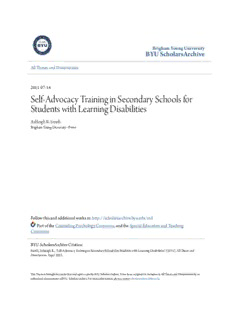
Self-Advocacy Training in Secondary Schools for Students PDF
Preview Self-Advocacy Training in Secondary Schools for Students
BBrriigghhaamm YYoouunngg UUnniivveerrssiittyy BBYYUU SScchhoollaarrssAArrcchhiivvee Theses and Dissertations 2011-07-14 SSeellff--AAddvvooccaaccyy TTrraaiinniinngg iinn SSeeccoonnddaarryy SScchhoooollss ffoorr SSttuuddeennttss wwiitthh LLeeaarrnniinngg DDiissaabbiilliittiieess Ashleigh R. Smith Brigham Young University - Provo Follow this and additional works at: https://scholarsarchive.byu.edu/etd Part of the Counseling Psychology Commons, and the Special Education and Teaching Commons BBYYUU SScchhoollaarrssAArrcchhiivvee CCiittaattiioonn Smith, Ashleigh R., "Self-Advocacy Training in Secondary Schools for Students with Learning Disabilities" (2011). Theses and Dissertations. 2823. https://scholarsarchive.byu.edu/etd/2823 This Thesis is brought to you for free and open access by BYU ScholarsArchive. It has been accepted for inclusion in Theses and Dissertations by an authorized administrator of BYU ScholarsArchive. For more information, please contact [email protected], [email protected]. Self-Advocacy Training in Secondary Schools for Students with Learning Disabilities Ashleigh Smith A thesis submitted to the faculty of Brigham Young University in partial fulfillment of the requirements for the degree of Master of Science Mary Anne Prater, Chair Darlene Anderson Gordon Gibb Department of Counseling Psychology and Special Education Brigham Young University August 2011 Copyright © 2011 Ashleigh Smith All Rights Reserved ABSTRACT Self-Advocacy Training in Secondary Schools for Students with Learning Disabilities Ashleigh Smith Department of Counseling Psychology and Special Education Master of Science To be successful in the general education students with disabilities may require accommodations. Students with disabilities need to develop self-advocating skills to be able to request the accommodations needed in the general education. This article describes a study in which six high school students with learning disabilities were explicitly taught to recognize when an accommodation was needed, select the appropriate accommodation, request the accommodation and then implement the accommodation in the general education classroom. The study indicated that students were able to advocate for themselves by requesting accommodations from their general education teacher. Based on data collected though this study, it is important for self-advocacy training to be implemented in the curriculum for all students with disabilities. Keywords: self-advocacy, self-determination, accommodation, learning disability ACKNOWLEDGEMENTS I would like to thank Dr. Mary Anne Prater, for her endless efforts as my thesis chair. I could not have accomplished all that I have without her support. I would also like to thank Dr. Darlene Anderson and Dr. Gordon Gibb, who were members of my committee. Their insights and suggestions helped me along the way and made achieving this goal possible. I am also thankful to all the professors at Brigham Young University. Each course was amazing and has helped me become the best teacher possible. I am grateful for the students and teachers who participated in this study. I appreciate the time and effort they were all willing to invest. I am also thankful for my family and friends, who took a backseat to my thesis work for the past two years. I especially want to thank my parents for inspiring me to always do my best and for putting such a strong emphasis on education. A special thank you to my future husband, Casey. I could not have finished this process without your patience and kindness. Thank you for sacrificing date nights so I could continue to be a diligent student. iv Table of Contents Introduction ..................................................................................................................................... 1 Statement of the Problem ....................................................................................................... 5 Statement of Purpose ............................................................................................................. 5 Research Question ................................................................................................................. 5 Method ............................................................................................................................................ 6 Setting .................................................................................................................................... 6 Participants ............................................................................................................................. 6 Students with disabilities.. ............................................................................................... 6 General education teachers.. ............................................................................................ 7 Special education teacher. . ............................................................................................. 7 Procedures .............................................................................................................................. 7 Materials .......................................................................................................................... 7 Data collection. ................................................................................................................ 7 Dependent variable .......................................................................................................... 8 Independent variable ........................................................................................................ 8 Lesson format................................................................................................................... 9 Experimental design....................................................................................................... 10 v Treatment fidelity........................................................................................................... 10 Interobserver agreement................................................................................................. 10 Baseline .......................................................................................................................... 11 Training .......................................................................................................................... 11 Post-training. . ............................................................................................................... 11 Results ........................................................................................................................................... 11 Grant .................................................................................................................................... 12 Baseline .......................................................................................................................... 12 Training .......................................................................................................................... 12 Post training.. ................................................................................................................. 12 Hadley .................................................................................................................................. 13 Baseline .......................................................................................................................... 13 Training .......................................................................................................................... 13 Post-training ................................................................................................................... 13 Don ....................................................................................................................................... 14 Baseline .......................................................................................................................... 14 Training .......................................................................................................................... 14 Post-training ................................................................................................................... 14 vi Eric ....................................................................................................................................... 14 Baseline .......................................................................................................................... 14 Training. ......................................................................................................................... 15 Post training. .................................................................................................................. 15 Social Validity ..................................................................................................................... 15 General education teachers.. .......................................................................................... 15 Students with disabilities. .............................................................................................. 16 Discussion ..................................................................................................................................... 17 Reflections of Findings ........................................................................................................ 17 Self-advocating behaviors. ............................................................................................. 17 Self-advocating training ................................................................................................. 20 Limitations ........................................................................................................................... 22 Future Research ................................................................................................................... 23 Implications for Special Education Teachers ...................................................................... 23 Conclusion ........................................................................................................................... 24 References ..................................................................................................................................... 26 Figure 1 ................................................................................................................................ 30 Results .................................................................................................................................. 30 vii Appendix A ................................................................................................................................... 31 Appendix B ................................................................................................................................... 51 Appendix C ................................................................................................................................... 81 Appendix D ................................................................................................................................... 83 Appendix E ................................................................................................................................... 89 Appendix F.................................................................................................................................... 93 viii LIST OF FIGURES Figure Page 1. Results .............................................................................................................................. 30 ix INTRODUCTION OF THESIS STRUCTURE This thesis, Self-Advocacy Training in Secondary Schools for Students with Learning Disabilities, is written in a hybrid format, bringing together traditional thesis requirements and journal publication formats. Its preliminary pages of the thesis reflect requirements for submission to the university. The thesis report is presented as a journal article, and conforms to length and style requirements for submitting research reports to education journals. The literature review is included in Appendix A. Appendix B contains the lessons and handouts used during the self-advocacy training. Both the general education teachers and the students completed a daily checklist throughout the study. These checklists are included in Appendix C. Appendix D includes the treatment fidelity checklists that were used throughout the study. Appendix E contains the social validity questionnaire that was given to the participants of the study. Appendix F includes the consents forms that were given to the participants and parents prior to the study.
Description: